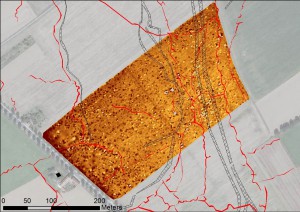 (Archaeological Prospection, 2013)
(Archaeological Prospection, 2013)
An Interdisciplinary Non-invasive Approach to Landscape Archaeology of the Great War
The prospection and evaluation of former battlefields of the Great War or the First World War (WW I) poses specific challenges. For several reasons, large-scale excavation campaigns of this conflict landscape are problematic. The vastness of the former Western Front (one of the largest archaeological sites in the world), the large amounts of buried unexploded ordnance and the possible presence of human remains hinder invasive practices. As an alternative, an integrated approach combining a geophysical survey, contemporary aerial photographs and a topographic model is proposed. This approach was evaluated for a 3.2 ha WW I battle field using a multireceiver electromagnetic induction (EMI) sensor. Integrating multiple apparent electrical conductivity (ECa) and apparent magnetic susceptibility (MSa) EMI measurements allowed evaluation of the present WW I remains in the subsoil, while comparison with WW I aerial photographs and a digital terrain model led to a comprehensive understanding of the WW I landscape. It is suggested that this approach may be of value for the investigation of battlefields in other locations and periods.
Reference:
Saey, T., Stichelbaut, B., Bourgeois, J., Van Eetvelde, V., & Van Meirvenne, M. (2013). An interdisciplinary non-invasive approach to landscape archaeology of the Great War. Archaeological Prospection 20 (1), 39–44. Published online 13 February 2013 in Wiley Online Library (wileyonlinelibrary.com) DOI: 10.1002/arp.1437